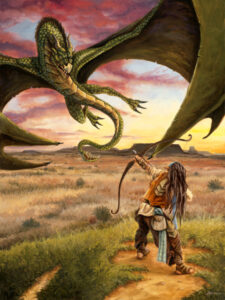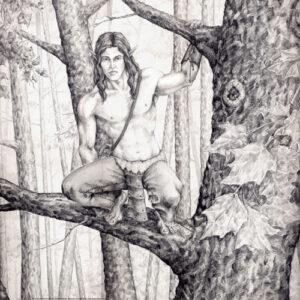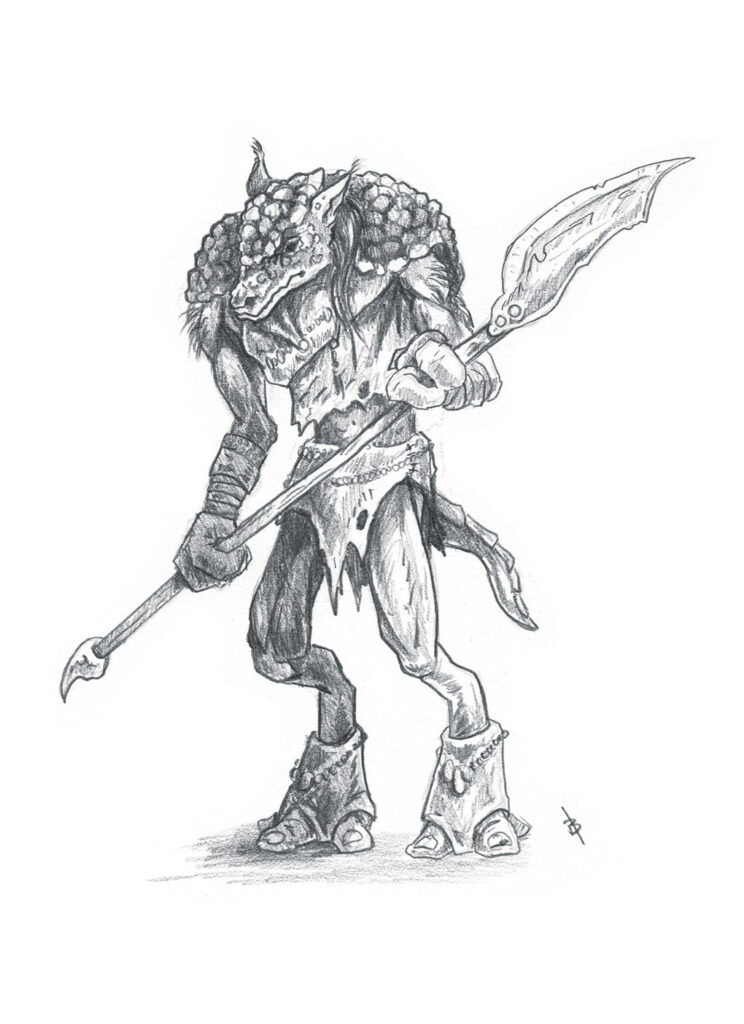The proper name for the “Wilde Elves”. also see Dwimarvari.
The Anarvari (Wilde Elves)
The Anarvari are a nomadic people. They are herders and merchants, entertainers and hunters. Many of our people have heard legends of the great Wilde elves, who hunt the giant kyzk, but the truth is that most of the Anarvari tribes sustain themselves on their herds of anks, large desert creatures that produce a honey-like substance that they store in sacks around their throats. Traveling the desert, looking for places for their herds to graze, they mostly keep to themselves, though some tribes have become renowned traders. Generally non-violent, the stories of them ransacking towns in the southlands are merely the fanciful stories of country-folk, frightened by the re-emergence of such a foreign people, and quick to blame every misfortune that befalls them on the newcomers.
The Anarvari live in extended family units within a clan, sharing possessions with their larger tribal family. Most live in large round tents, but some tribes live in giant caravan wagons, pulled by orillots. These huge mammals are another domesticated animal of the south, which have armor plating on their backs and form strong bonds to their owners. The Anarvari say they originally trained our own kind in the distant past to care for these giant creatures. In the Ishian Empire, you can find nobles traveling from city to city in giant ornate wagons pulled by a team of orillots—a remnant of what we learned from the elves so long ago.
The Anarvari do not have close relations with other elven nations, keeping to themselves in the southern lands.
The Lands of the Anarvari
In current days, the Anarvari live in the Wildelands between the Kaelnor Forest and the Jal Dur desert. Some tribes still cling to the steppes of the western end of the Wildelands, though most tribes travel back and forth in the plains with their herds of domesticated animals.
The Wildelands is an arid area, covered in short grass and small spindly trees. The flat landscape is broken only occasionally by rock outcroppings or buttes. During the day, the sun warms the plains, but at night, the temperature drops considerably.
No kingdom claims the Wildelands, though the Teredeki elflings have lands in the northwest, and Southkeep is on the border between the Wildelands and the Jaldur desert.
Anarvari History
The Anarvari were never part of the larger elven culture. This has led other elves to call them the Dwimervari which means the fading people. During the time that the elves served under the Eldar, the Anarvari remained separate, neither serving the Eldar nor learning from them. This allowed the Wilde elves to develop a much different culture than the other elves.
During the Time of Servitude, the Anarvari were viewed as an affront to the Eldar culture and were villainized and hunted. The Anarvari only survived by living in the harshest of regions and leading nomadic lives. After the Eldar were destroyed by Kaldrath, and the Elven Wars divided the surviving fey cultures, the Anarvari withdrew into the deep desert, keeping to themselves and staying free of the power struggles of their brethren.
As the human kingdoms rose and spread across the land, the Anarvari were more open to them then the other elves. This peaceful coexistence lasted for many years until the rise of the Ishian Empire. To the Ishians, the Anarvari were viewed as a threat and the Wilde elves once again found themselves persecuted and hunted. This genocide came close to destroying their kind, until they escaped by retreating to the Steppelands of the coast. The harsh land and creatures of the Steppes kept the Anarvari population low.
After the Aradan War, when the Ishian Empire’s failed conquest into the Westlands weakened their hold on the Jaldur Desert and the Wildelands, the Anarvari seem to have faded from history. The plains they once roamed lay empty and unclaimed, and the Anarvari were nowhere to be found. Some believe they went into hiding in the steppes to the west, while others think they left to other realms of existence.
Having disappeared for the past 700 years, the Anarvari were untouched by the plagues that ravaged Uteria, and their population seems to have grown.
Now that they have returned, the Anavari have formed a cautious treaty with the people of the desert. Lately, it is not uncommon to find the Anarvari walking the streets of South Keep, and the city generally views their people as an important ally.
Society
The Anarvari are a tribal culture, and each tribe is lead by a council of elders. The entire tribe votes for larger issues, but day to day life is guided by the elders. All of the Anarvari participate in the yearly Gathering at the Grove, which is a valley oasis in the western part of the Wildelands. A council of shamans lives in the Grove during the year. At the Gathering, the different tribes trade, celebrate unions, and discuss matters that involve the entire Anarvari nation.
Unlike many human cultures, the Anarvari are not patriarchal. Males and females alike sit as elders, and work is assigned based on the aptitude of the person regardless of gender. Though most belongings are shared among the tribe, individual items can be owned by both sexes. One interesting thing to note is that children are born “to” the mothers and “for” the fathers, and take the mother’s surname.
Marriage among the Anarvari is monogamous, and is always conducted between different tribes. This allows the tribes to establish ongoing bonds with one another and binds the Anarvari together.

Beliefs and Culture
The Anarvari believe that they came from beyond the stars and that they were brought here by Arias and Tanthias. In their lore, Arias the Earthmother fell asleep after teaching the ways of the land, and slowly the sands covered her as she hibernated. In her sleep, she became bound to the land, and now all that is of the earth is a part of her. Tanthias, who missed her greatly, pulled part of the oceans up into the sky so that he might look down upon his wife everyday. His shining throne is the sun, and the moons which come out at night are their children. In these places they keep their children under their protection and watchful gaze.
Another part of Anarvari culture which is important is the tattoo. The markings on a wild elf, sometimes subtle, sometimes bold, mark his or her place in the Anarvari tribe. Often shamans and warriors cover their bodies in markings and symbols, denoting their own personal stories and triumphs.
The Grove is a place of importance to the Anarvari. In their lore, a star fell from the sky one winter day, and the sound of the star hitting the ground could be heard for leagues. The Anarvari stayed far away from the place for many years, until a great drought forced them from their normal water sources. It was then that they discovered that the crater left by the star was filled with great trees and a lake sat at its center, fed by cool springs. They took this as a gift from Tanthias, opening the ground to share in Arias bounty during this hard time. Since then, the Anarvari have viewed this land as sacred and have guarded it from outsiders.
The Kyzk, a giant horned beast that roams the Wildelands, is held in high regard in Anarvari beliefs. The four legged creature stands almost twice as tall as a man at its shoulders, its giant horns the size of an arm, and its tusks the span of two hands. When the Anarvari hunt these creatures, it is with great reverence. Every part of the Kyzk is used, as it is a sacred gift in an unforgiving land. The Anarvari believe the Kyzk a gift from Tanthias himself, but corrupted by Rindlebok, the god of mischief.
The Gift of the Kyzk
One summer, a millennia ago, the sands stretched much wider than they do today and the sun was in the sky for days. Berries fell from the shrubs and dried before they ripened. Animals left bones along the paths. The People were starving. During a cold night, the People prayed to Tanthias and asked him to guide them. They laid their hands on the ground and asked Arias to provide for them.
The next day, a herd of giant horned animals were surrounding the camp, their eyes sorrowful for the slow death being visited upon the People. Though no words were spoken, a bond was created and the first Kyzk offered itself to feed and clothe the People. The Kyzk, gift from the Couple, saved their tribe.
But Rindlebok did not like this bond and became jealous. He took the form of a dog, and one night, he ran among the Kyzk. He nipped and bit, and barked many stories of the People, warning the Kyzk that it was the Anarvari who brought this death to the lands; that they used their witchcraft to tame the animals before they slew them. And the Kyzk listened. In the morning, the Kyzk were gone. Since this time, the People must hunt the Kyzk, as they will no longer lie down willingly. They do this of necessity for survival, though still they honor and respect the gift that Earth and Sky gave to them in this harsh land.
Warfare
The Wilde elves use the weapons of the hunt when they join in combat. Skilled both at the spear and the bow for attacks from a distance, many enemies do not even get close enough for melee combat. If the assailant does come within reach, they are met with a skilled foe, usually wielding a flint-like knife. I have seen many of these in my travels with the Anarvari, and unlike normal stone, these do not chip or crack. My companion explained that there is a skill involved in its making, but she and others would not divulge their secrets to me. One night I was allowed to hold one for a moment, during a late night dance ritual. It did indeed feel to be filled with magic, but when I asked my companion later, she just laughed and said that the elves do not have magic. They only have what they make. I feel that the common language was not sufficient to explain her meaning.
It seems that the Anarvari have used other cultures’ fear of their “wildness” to their advantage. The rituals and practices they perform to honor the animals which feed and clothe their tribes have been viewed as barbaric to many among us. Often they wear the skulls, bones, and hides of these animals. This is viewed as a way to honor their sacrifice, but to outsiders this seems strange and horrific. The elves have adapted to these views and use this distance between our cultures and theirs to allow them their peace-seeking life.
This does not protect them from all other creatures, however. The angrolls, for example—a bloodthirsty and savage race of bipedal creatures—savagely hunt the Anarvari. The wyvere of the Steppelands also hunt the Anarvari, but do not single them out. Anything that travels along the canyons and cliffs of the western Wildelands are the prey of the wyveres.
Magic
When an Anarvari reaches the age of maturity, he or she embarks on a dream quest. Alone, on the night of his or her birth celebration, the young Anarvari must enter a giant tent with the elders and shamans of the tribe. There the disciple will consume a beverage concocted of local herbs and roots which will cause the mind to enter a trance. It is their belief that during this trance the consciousness enters the dream plane, and it is there that the Anarvari finds his or her calling. This ceremony takes a full night and day. At dusk of the following day the elf awakens and describes his vision in as much detail as possible. Then a great celebration is had, and the young Anarvari often gets his or her first tribal marking.
Those who become apprentices of the Arts—what we call magic, but what they insist is merely union with nature—are chosen by the shamans of the tribe and enter into training. Anarvari magic is subtle, often using natural components and music along with spellweaving. Like the Druids, they view magic as an extension of the five elements, so young shamans often pledge themselves to an element for their studies.



